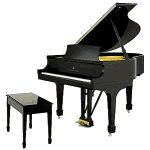

Composers from Amazon.com's Get Started in Classical:
| Bach | Glass | Schubert |
| Beethoven | Mahler | Stravinsky |
| Copland | Mozart | Tilson Thomas |
| Corigliano | Mutter | Wagner |
| Debussy | Pärt | Zimerman |
| NEW! Huang Additional composers and musicians |
||
Igor Stravinsky
This is from Amazon.com's Get Started in Classical.
Igor Stravinsky's early ballets were a defining point of musical modernism and continue to exert their thrilling power
From our perspective at the close of the 20th century, we have a clearer view of the various revolutions in music that so dramatically punctuate the modern era. These have included both frustrating dead ends and exciting breakthroughs. And as for the latter, there can be little doubt that Igor Stravinsky (1882-1971) presented the century with some of its most colossal examples. In fact, the achievements of his long, richly creative career still maintain their startling power and charge, and they continue to inspire a host of composers at work today. Like the distinct phases that subdivide the work of Picasso, Stravinsky's music evolved through a series of sharply contrasting styles. He first shook the music world to its core--after an astonishingly brief period of traditional apprenticeship--with a succession of ballet scores based on memories of his native Russia. If you define yourself as someone for whom "modern music" has always seemed like a distressingly foreign language, these ballets of Stravinsky's first great period make an excellent and thrilling place to begin.
For all their significance as landmarks of a new approach to the composition of music, they quite simply offer captivating sonic experiences: all you need are open ears to enjoy their vibrancy of color and explosive surges of energy. In Pétrouchka, for example (written in 1911 for ballet director Serge Diaghilev and danced by the legendary Nijinsky), Stravinsky stages the carnival backdrop against which this story of a jealous puppet unfolds with swirling patches of musical activity. In place of the traditional statement of full-length melodies and linear development of material, he abruptly cuts from one episode to another, then repeats, and--foreshadowing the experiments of a postwar generation of electronic composers--splices these fragments together. The effect is rather like that of the technique of film montage, inviting a new kind of involvement on the part of the listener that replaces the long-reigning Romantic notion of music as subjective self-expression.
You will also hear Stravinsky's unmistakable signature in his brilliant mixture of a rich palette of instrumental timbres--he was after all a student of the great orchestral colorist Rimsky-Korsakov--and in the score's rhythmic vitality. One of Stravinsky's great achievements was to unleash the powerful element of rhythm from what had been a largely subservient role in Western classical music. By making rhythm a primary focus, Stravinsky would have a seismic impact two years later with The Rite of Spring (1913), one of the touchstones in the era of modern music. One could spend a lifetime dissecting the complex array of rhythms sounding simultaneously in different meters throughout this score; but the visceral reaction they awaken, together with Stravinsky's fabulous dissonances, is immediate and unforgettable. At the same time, you won't fail to notice the unique quality of colors Stravinsky draws together, particularly in his expansive use of woodwinds in the opening of Part One. The sense of pagan antiquity and primordial nature crackling to life that begins with the bassoon's bizarrely high-pitched first note and then stretches through a motley choir of winds is one of the most astonishing sounds in all of music. These accounts of both scores are particularly fine: conducted by Pierre Boulez, an authority on modern and contemporary music, they impart the kind of maximum clarity and precision for which Boulez is celebrated. This is an essential disc for anyone setting out to know and enjoy the music of our time.
Thomas May, Classical Editor
More Stravinsky can be found in Musical Information and Recommendations for Adults.
O'Connor Music Studio Recommendations
lists Books, CD's, Cassette Tapes, Computer Programs, Music Scores DVD's, Videos and more
from amazon.com, as well as several other sources.
 If you are looking for ideas for children's books, cd's, cassette tapes, computer
programs, games and toys, click here for some ideas.
If you are looking for ideas for children's books, cd's, cassette tapes, computer
programs, games and toys, click here for some ideas.
Many thanks to Dearest for everything!
is located
in Fairfax, Virginia
Over 30 Years
~~
Piano, Organ
Electric Keyboard
Accompanying
Email Mary O'Connor
All rights reserved.
Site design and maintenance by
O'Connor O'Riginals Web Design